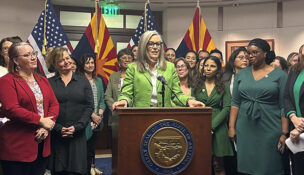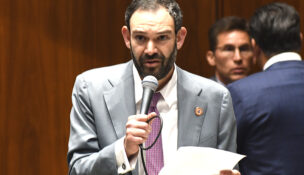Up Close with Rep. Tom Boone, appropriations chairman
Arizona Capitol Reports Staff//May 12, 2006//[read_meter]
Up Close with Rep. Tom Boone, appropriations chairman
Arizona Capitol Reports Staff//May 12, 2006//[read_meter]
Tom Boone heads half of the House’s two-headed approach to appropriations, chairing the Appropriations B Committee. A former superintendent of the Deer Valley Unified School District, the District 4 Republican was the driving force behind the bills passed by the Legislature in response to the Flores v. State of Arizona lawsuit.
As the legislative session winds down, Mr. Boone sat down for an interview with Arizona Capitol Times on May 10 to shed some light on the budget process.
The biggest responsibility of the Legislature is to craft a budget for the state. How difficult is it to create a spending plan that pleases enough people, in both the Legislature and in the Executive Branch?
Well, it’s extremely difficult. It’s a real balancing act because — this is my fourth year down here — when I first started off here, I came in and there was a $1.3 billion deficit projected. It got better the next year — I think it was $200 million the next year — and then last year we were looking at a small surplus, and then this year, of course, you have what we have. Depending on whose numbers you use, it’s about $1.8 billion increase over the prior year — a significant increase.
What happens is the expectations changed from, coming into the session folks knowing we’re going to have to be frugal, knowing we’re going to have to make cuts, knowing that we just needed to balance things. Nobody had an inclination to ever raise taxes to balance the budget. Totally different from now because now we’ve got, pent up over the four-year period of time, pent up requests from members, whichever side of the aisle they are. Balancing all of that at this point in time and finding enough to satisfy everybody is a real challenge because there’s not enough money.
The state agencies’ requests alone were something like $1.4 billion more than what we even thought we’d be close to having available for next year. And that was just the legislative agency requests that were submitted through JLBC — above and beyond the statutory requirements we have to fund, things like automatic growth in education, automatic growth in AHCCCS, et cetera.
So, it’s a very difficult task, balancing everybody’s requests because they’ve been pent-up now for four-plus years and they’re very difficult to please in one budget year.
How would you describe the process in one sentence?
It’s the act of juggling the requests, desires, needs and wants to get at least 31 people in the House, 16 in the Senate and one in the Executive to sign it.
From the outside looking in, it seems as though it took leadership an awful long time to begin serious discussions with lawmakers and the governor on what to do with the money left over after the appropriations committees approved the state agency budgets. What led to the delays?
Well, I think, just to put the delay in perspective, when we came into the session we had great expectations on being out of here in 82 days and that was, obviously, in retrospect now, overly optimistic.
What’s happened has been, I think, a combination of things. First of all, revenues have continued to get better and better and better. So, all of those things we were juggling, in terms of wants, needs and desires, tend to escalate as available revenues tend to go up, which has happened this year. They started large and they’ve only grown.
But, I think if you put it in perspective of where we were last year; I think we’ll only go a little bit past that this year. I think the fact that we have so much more in funding to deal with this year makes the problem of getting the budget balanced and come up with a final product, it just makes it that much more difficult, because all those needs, wants and desires become modified as there becomes more revenue.
Did the Flores issue impact the budget at all?
Good point. I think the Flores issue threw us behind because when the judge set the order in December, that set the stage for doing nothing but ELL for the first 15 days. That dragged on, as you know. We went past that by a couple of weeks. But that was our concentration at the beginning of session. That started us off behind.
Do you think it will be possible this year to create a budget that will be signed by the governor, but still get 31 Republican votes in the House and 16 in the Senate?
I think so. I’m optimistic.
What we’re doing right now, we’re spending a lot of time in joint leadership meetings. We’re meeting every day; most of the time, two meetings a day. What we’re trying to do right now is come up with a final product.
The process so far has been that any bills dealing with money, if they’re individual bills, have been passed into the other house — from the House to the Senate and the Senate to the House — and then are held for these very discussions. So, what we’re doing at this point in time is taking anything and everything that has to do with money — whether it’s a bill or it’s a request in the budget meetings we’ve had in the small groups — we are meeting to examine any and all of those. Everything is on the table between joint leadership. We’re including everything, including, now, after several meetings with [Governor Napolitano], the governor’s requests also. We went through agency by agency, issue by issue, with the governor, just like we did with members.
That’s why this is taking so long now, because we’re trying to balance all that, trying to come up with a package that addresses the major priorities of the Republican caucus in both the Senate and the House, and also the governor. And that’s why I’m optimistic that we’ll get something that I believe the governor will sign.
Do you think the Legislature and the governor can agree on a budget the first time around, or are you going to have to pass multiple budgets like last year?
There’s no interest this year in sending something up to the governor that we anticipate she’s going to veto and then start over again. There’s no interest in that.
So, the Senate president and the speaker have had more meetings this year before sending anything up to the governor than we had last year, there’s no question about that. They spent a lot of time with the governor. I anticipate that, when we get finished with a tentative package and we talk to our caucus about it and get their approval, then I suspect the president and the speaker will have some additional conversations with the governor.
Speaking of your caucus, how would you characterize it? With 39 people, there are bound to be a wide variety of concerns. Are there groups of members that vote a certain way on specific issues and how do you appeal to them when making a budget?
I see some major areas of concerns where I see groups of people grouping together on an issue. There’s those that — say, on transportation — want to use a significant amount of money to expedite construction projects, particularly those dealing with roads and highways. I see a large group of people, a significant group of people on both sides, the Senate and the House — I can speak more for the House than the Senate — that are interested in putting much more in transportation.
As you know, to back up, we had small group meetings and we had a basic structure to show, Here’s what we’re thinking and here’s some of the allocations. There was money left that we were figuring out how to use, so we got many of those priorities already from those small groups [meetings] and that’s what’s come out: much more for transportation.
We’ve got some [members] that want some very significant amounts of money put into the issue of illegal immigration and they want a comprehensive package. We just had a caucus meeting on [May 8] and outlined some structure. What we’ve gotten back from that was issues like, for example, the $30 million in grants that we were talking about is kind of a beginning point. All the feedback I’ve gotten from members is that they’d like to see more. Because, if we really want it to be an effective package and have local law enforcement, local prosecution, incarceration costs and things like that, that counties and cities incur as a result of clamping down on this area, we need to provide them some funding. I think there’s a willingness to go beyond the $30 million — that’s the opinion I’m getting from the caucus.
I see some groups around the tax issue. The big issues on the tax issue are whether it should be income tax or property tax or a combination of both. We’re kind of at a combination of both at this point, but now the problem is the multi-year. We had been talking about a three-year package, which would go up to about $800 million in the final implementation year. I think there’s some members that feel uncomfortable with that and would like to see that scaled back some. There’s some real concern about doing anything multi-year. I have a concern over any multi-year commitment, whether it’s on the spending side or on the tax side, personally, myself. It’s a concern that we’ve got to deal with.
Last week, Governor Napolitano said she would only sign the budget if it was accompanied by a comprehensive immigration plan she could support. How does that impact the budget?
Any illegal immigration package, if, in fact, it’s comprehensive and includes employer sanctions, money for cities and counties to deal with the costs of prosecution and incarceration, law enforcement, et cetera, is going to cost money, which makes it automatically a part of the budget in some fashion. I think the question is a matter of timing. We’ve been working on the border package for quite some time and it seems to be coming together now as a comprehensive package.
My personal feeling is I’d like to see us move out an illegal immigration package — a border package, border security package; however you want to call it — a comprehensive package dealing with illegal immigration. I’d like to see it moved out as soon as possible. Whether or not that coincides with finishing the budget, we have to go through a process with our members on the entire budget so I don’t necessarily see those being done at the same time.
I understand what the governor said, but I think that the illegal immigration issue is a top priority for us and I believe it needs to be dealt with. And if it comes along faster than the budget, then I believe it needs to be addressed by us and the governor in that sequence. And if the budget comes along in the process at a later date, then so be it.
We’re working on both of them at the same time. It depends on how the groups and issues are worked out if they happen at exactly the same time or not. I understand what the governor has said, I understand her position, but it remains to be seen whether we send it up before or with the budget — it depends on how the both come along.
Do you see her linking the immigration plan with the budget as a sign that she may concede to some of the Republican budget ideas in exchange for your compromising on some immigration issues?
Well, I hear the governor say she wanted a comprehensive plan. I think that the governor, in my opinion, is looking for a little bit of cover from the issue at this time, wanting to be a part of the plan, maybe mitigating some of the areas she finds objectionable in a comprehensive plan by doing that.
When we’re talking about a comprehensive plan, we’re talking about anything and everything that’s been on the table dealing with illegal immigration, whether it’s the law enforcement, employer sanctions, the border security — dealing with the National Guard, technology, radar — to the Prop 200 issues, dealing with public assistance. She’s vetoed individual bills on those for quite some time. But when we think of a comprehensive package, that’s what we’re thinking about.
I believe the governor’s looking for a little bit of cover because I think this is the No. 1 issue out there in the public right now, and by trying to link it to the budget she has a little bit more control over the process of how those develop, so that she can negotiate, perhaps, portions of the illegal immigration package that she might find more palatable to her and many of the Democrats in the House and Senate.
I don’t believe the Republican caucus is willing to step back on many of the significant principles and issues that we want to deal with with illegal immigration. We believe it should be comprehensive and address all those areas. Some of them, I think, she’s going to object to, and by linking them she has a little bit of cover, but I’m not so sure we’re going to go along with sending them up. That’s a decision that’s going to have to be made by leadership, not just me.
Let’s talk about your education reform bill for a second. Why, ultimately, did it fail?
I think what happened was I just ran out of steam on it because it got too late. What happened was — and you could see it in general on the budget — we didn’t get started until late because of the ELL [English Language Learners]. Well, the ELL is one of my main issues. I’ve been working on that last year and went right into working on it this session. That took a lot of my time away from the time I’d normally have to introduce a bill and work it in the Senate and the House so people could understand what it was.
It’s easy when you have a comprehensive package like it was. School finance is difficult and complex in the first place. I was trying to resolve a lot of the issues that have been outstanding for quite some time: Career Ladder funding inequities, excess utilities, et cetera. I just ran out of time, I think, because of starting late, to explain it to people.
What I’m finding now is I’m getting calls — you know, I sent a fact sheet for the bill out directly to superintendents and all charter schools. It’s interesting now because it’s filtering out to the school board members and what not in the community and some administrators that hadn’t paid much attention before. Now I’m getting calls saying, “What’s the status of this? This looks like a pretty good thing,” which is kind of interesting.
It takes time for that information to filter out. Schools are real slow in absorbing what’s going on in the Legislature. They just are; for whatever reason, it just doesn’t percolate to the people or to the level it needs to gain the support.
I just started too late, to be quite honest; otherwise I think it would have been much more successful than it was.
Will you bring it back next year?
If the issues aren’t addressed — which I don’t anticipate they will be — I’ll be bringing it back next year. And I’ll have an earlier start next year. I think I was close to getting it voted out of the House [this year]. I had 31 people and just ran out of steam at the end. Then we had an uphill battle with the Senate because I hadn’t been over there explaining it. I think it was just too much this year. That doesn’t mean I think it was something we shouldn’t have done — I’m glad I did it — but I’ll do it again next year.
Aside from your work on the budget, what legislation was the most important to you this session?
The others are dealing with renewable fuels, with clean air. There weren’t as many as I wanted to do, but I think we’ll end up with a few significant ones. Two bills have been signed by the governor so far.
She signed H2590, which deals with E85, which is ethanol. That will allow retailers to sell E85 ethanol, which is being promoted by the federal government through the federal energy act. I think you’ll see a lot of the retailers in the Valley offering that. I think the demand will gradually increase. There’s a lot of car manufacturers now — in fact, I bought one myself: I bought a 2006 Impala that comes from the factory being able to run on either unleaded gas or E85, either one. I’m really proud of doing that legislation.
I’m also proud of the one that we did on the CNG buses, which is utilizing the balance of the funds we have in the Clean Air Fund through June 30, 2008, to give to school districts to pay for compressed natural gas bus differential costs over diesels. I think that’s going to be very helpful to cleaning up the air.
Then my final bill, which hopefully I’ll get passed, is a striker to S1346. That is a bill that encourages the use of, in all of the public fleets — school districts and government — biodiesel and ethanol to gain credits for the Alternative Fuel Vehicle requirements they have from state and federal law that’s in place. They have a certain number of vehicles they have to have converted — 75 percent of their fleet, now, that have to be alternative fuel vehicles — and they’re having a hard time meeting that because alternative fuel vehicles are defined as propane, natural gas and electric. Many manufacturers aren’t making many of those cars anymore, so it’s hard for them to keep up with the requirements. What I have in the bill — and I’m also pushing to get it in the budget if it doesn’t make it in my bill — to allow all these fleets to use biodiesel and ethanol. I think that’s a big step.
The reason I’m running those bills, and I also have the one for a property tax incentive for a biodiesel plant or ethanol plan built in the state of Arizona — we don’t have a biodiesel plant right now. I think all of that is very critical, in my opinion, for the United States to move away from being oil dependent. Right now we’re importing about 47 percent of our crude oil. I think that is strategically a very bad thing, from a security viewpoint. From an economic viewpoint also, and stability. I think the more that we can convert to renewables, the better off we’ll be and I think Arizona can be on the cutting edge of doing a lot of this. That’s why I’m promoting these things.
As the little brochure says about ethanol, “It would be better to get your fuel from the Midwest rather than the Middle East.” I think everybody can buy that. And if we can produce it here in Arizona, I think that makes it even better than the Midwest.

















